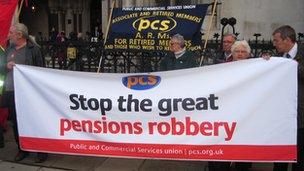Career average pensions for the public sector
- Published

Moving from RPI to CPI has led to legal action, with strikes in the offing over higher contributions
The design of huge, new, pension schemes for more than five million staff in the public sector is starting to emerge.
Following the recommendations earlier this year of Lord Hutton's independent report into the future of public sector pensions, the government is negotiating with public service trade unions.
One of Lord Hutton's big ideas was that all staff in the public sector should be moved out of their current pension schemes.
That would apply to staff in the NHS, local government, civil service, schools, and the various "uniformed" services: the armed forces, fire brigades and Police.
They will be offered instead membership of so-called career average schemes, from 2015.
Until now, it has not been clear exactly how the government intended to design these new pension arrangements.
They can vary in detail very considerably, and the detail can make a big difference to how much they cost to fund, and how generous or meagre they are for employees.
What we now know
The BBC has learned all the main details, which means we can now assess how these schemes might compare to those currently in place.
The main features are these:
The higher pension contributions now being asked of public sector staff in their mainly final-salary pensions - averaging an extra 3.2% of their salaries over the next three years - will carry over to the new schemes. Contributions will be less for lower earners.
The standard 'accrual rate' will be 1/65th. On a salary of £20,000 this gives a pension of £308 a year for each year worked. This is less than the 1/60th accrual rate in place for most final-salary schemes currently, which gives a pension of £333 for each year worked. However, working longer could mean a bigger pension at retirement.
The revaluation of pension entitlement each year during accrual will be in line with a measure of average earnings, to protect pensions from inflation as they are being built up. That will mean better pensions for many workers, particularly women, and means the perception that all staff will necessarily receive smaller pensions is wrong.
The normal pension age will rise in line with the state pension age (SPA), which will increase from 65 to 66 by 2020, and to 67 by 2027 as life expectancy increases.
Pensions in payment will be inflation-proofed, rising in line with the consumer prices index (CPI). Benefits under the current schemes were previously linked to the Retail Prices Index (RPI) but with effect from April 2011 they changed to using CPI. This change is currently being challenged in the courts by trade unions.
Why bother?
From the government's point of view, the proposals are designed to address the rising cost of pensioners living much longer and the perceived unfairness of the current final-salary pension system.

Some staff will be better off in a career average scheme, argues John Wright
The government wants to maintain the amount that workers receive in retirement (especially for lower earners) but preserve guaranteed, salary-linked benefits that are increasingly rare in the private sector.
The reforms will affect only future pension entitlements for existing scheme members from 2015.
Individual schemes will not be forced to stick to exactly the same scheme design, provided any differences are affordable within the budget that the government has set for them (the 'cost envelope').
The government wants the overall costs of these schemes to be less than at present, and to fall much more on the employees than they do now.
The new NHS scheme should cost no more than 20.2% of salaries, with staff paying 9.5%.
The new civil service scheme should cost no more than 20.8% of salaries, with staff paying 5.6%.
The new teachers' scheme should cost no more than 20.1% of salaries, with staff paying 9.6%.
The new local government scheme should cost no more than 17.3% of salaries, with employees paying 8%.
There is scope though for schemes to agree important features to suit themselves, such as the severity of pension reductions ('discounting') for those staff who take their pensions before the normal pension age.
The government is apparently even open to the idea of a final-salary structure being retained for an individual scheme, if there is a trade-off with a diluted accrual rate, so that the overall cost of the scheme is still cut and then kept within its desired limits.
It is less likely that the government will agree to schemes moving away from retirement at SPA, since this is critical to keeping costs under control and making the schemes sustainable in the long term.
Two pensions
It is important to remember that these changes, if finally put in place, will apply only to future pension entitlements from 2015.
Pensions already earned (accrued rights) will be protected in full.
These will still be payable on retirement on the basis of a worker's final salary, and at the original pension age, even though the staff will not have accrued any more years of service in their old scheme after the change over has taken place.
So someone whose salary rises between 2015 and eventual retirement will receive more at retirement from their old scheme than if their pension had simply been payable when the change over took place.
They will of course accrue a second stream of pension income under their new scheme.
Hymans Robertson research shows that this message is not getting across - better communication is crucial.
People already have difficulty understanding their existing pensions, let alone these latest proposed changes.
Much more education is needed to help people understand their pensions and how valuable they are.
How will scheme members be affected?
What really matters is what all of this means in pounds, shillings and pence.
Here is a typical example for a (fictional) civil servant, Tom.
So, Tom will have choices:
Retire at age 60 and get a smaller pension.
Work just over two years longer (to age 62 and three months) to get the same pension.
Work to the new retirement age of 67 and get a bigger pension.
A good deal?
There is no doubt that Tom will have to contribute more and work longer to get the same pension as before.
The government makes no bones about this.
But it is important to remember these new schemes will still be among the best on offer in the UK.
In a typical private sector defined-contribution scheme, average contributions are currently around 10% of pay (including 6% or 7% from the employer).
So the total cost of providing Tom's benefits under the reformed public sector schemes would be between three and four times that amount.
This does not mean that public service pensions are too generous.
The question that remains is how to improve private sector pensions to adequate levels.
The opinions expressed are those of the author and are not held by the BBC unless specifically stated. The material is for general information only and does not constitute investment, tax, legal or other form of advice. You should not rely on this information to make (or refrain from making) any decisions. Links to external sites are for information only and do not constitute endorsement. Always obtain independent, professional advice for your own particular situation.